The final type of landscape painting which is often lumped with the Burkean sublime is that in which the artist’s internal (or ‘higher’) vision starts to become dominant: most obviously in the ‘Romantic’.
These Romantic visions might include the truly Burkean sublime, as they did for John Martin and his apocalyptic. But in many cases the internal vision was a broader religious or philosophical basis which extended far beyond fear, horror and awe.

There are of course no clear dividing lines between the realist and the Romantic, nor between the regular Romantic and the deeply introspective extremes of William Blake, and others. Although there are recurrent themes and ideas in Romanticism, each artist’s vision is very personal. So rather than attempting a historical survey, I will focus on two painters whose visions were particularly clearly articulated, and contrasting: Caspar David Friedrich and Samuel Palmer.
The tragedy of landscape
Caspar David Friedrich (1774-1840) is the best known German Romantic painter, and from his early days after training produced numerous paintings ranging from fairly conventional realist landscapes to very dark and visionary works. He laid emphasis on the artist painting what he sees within him, and condemned work which was purely representative in, and of, nature.

In his early painting The Abbey in the Oak Wood (1808–10), Friedrich offers us a very dark vision of death, gloom, and the depths of Gothic horror. This painting shows the ruins of a church amid gnarled and barren trees, silhouetted against a twilight sky. Hanging low in the sky is a thin sliver of the new moon. In the gathering murk, we can just distinguish the dark shadows of graveyard memorials, and a funeral procession bearing a coffin into the remains of the church entrance. Even the horizon is lost in the cloak of darkness which covers the land.

His marriage brought Chalk Cliffs on Rügen (after 1818), almost the exact inverse of that earlier work. Here are dazzling white pinnacles of chalk, a calm sea with sailing vessels, shown in full daylight, the whole framed by trees in full leaf to enhance depth.
But Friedrich leaves us with a puzzle: the figures might represent his bride (clad in red, symbolising love) and himself, both engaged in studying the clifftop from its edge, but there is a third person: a man wearing a tricorn hat (which becomes a recurrent theme in his work), arms folded, staring out to sea as if the couple were not there at all. It has been suggested that this third figure is Friedrich the artist.

There is another puzzle too. That painting is conventionally dated to the year of his marriage, 1818, but a watercolour work which would appear to have been a study for it is normally thought to have been painted some years later. As a watercolour study, Chalk Cliffs on Rügen (c 1825-6) may have been painted plein air or shortly after seeing the motif.
Although superficially it seems to show the same view as the oil painting, without the figures, there are many differences which show how Friedrich transformed the real to express his inner vision. The chalk pinnacles are less needle-like and precipitous, the trees smaller and they do not form any repoussoir, and a white chalk beach is visible below, making the cliffs appear less dizzying.

Although set in full daylight, Wanderer above the Sea of Mists (1818) uses extensive mist and cloud both to detach its scenery from ground level, and to maintain a pervasive air of mystery. A bareheaded, blond man stands astride a rocky outcrop in the foreground, a walking stick in his right hand. He looks out over a blanket of lower cloud, pierced by occasional rock pinnacles and peaks. In the distance, more gradual slopes suggest higher mountains to the sides, and vaguer forms of rounded peaks, and a massive rocky butte, fade into mist.
Because he faces away from us, we are left speculating whether the man is enjoying solitary mastery over the landscape, or is in awe or fear of it.

Moonrise Over the Sea (1822) returns to a world of darkness and shadow, showing the view from a boulder-strewn beach, looking out to sea as the moon rises from behind a bank of cloud. The sea is calm, and glistens in the moonlight. Two fully-rigged sailing ships head straight towards the beach, the nearer furling its sails so as to lose way, the further still under full sail. On the top of the largest boulder, in the middle of the painting, are three people: two women sit close together, a man slightly to their right, all three gazing intently at the ships.
Friedrich painted several similar scenes, showing various figures on the shore and vessels at sea, revealing the importance to him of this particular view, enigmatic though it might appear to the viewer.
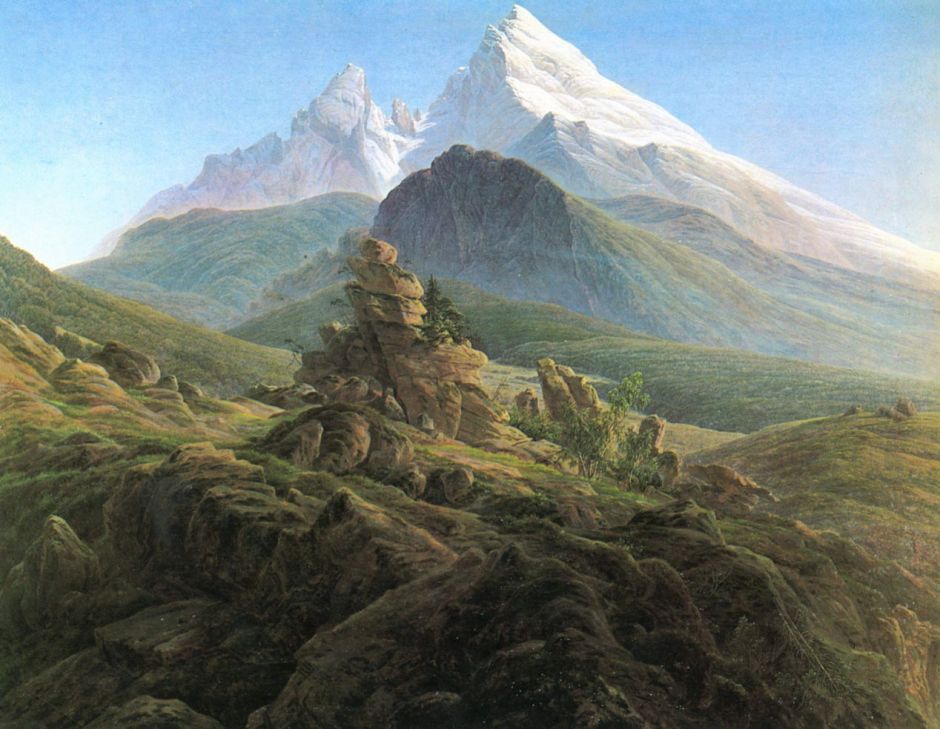
The Watzmann (1824-5) is a deserted mountainous landscape, seen in full daylight. In the foreground are rock runs and barren land, with patchy low grass, behind which are tottering rock pinnacles bearing a few trees. The middle distance contains rolling forest, behind which the land rises abruptly in a rock cliff, and a rock hill showing intensely folded strata. In the far distance are a pair of sharp peaks, snow still burying their crevices and chimneys, and covering the tops. The nearby pinnacles, distant cliff, and the closer of the two peaks are aligned.
The Watzmann is the third highest peak in Germany, and is south of the village of Berchtesgaden, in the Bavarian Alps. Friedrich’s painting appears to show the mountain and its environs quite faithfully, although all signs of human habitation (including perhaps the village itself) have been replaced by rocky and barren land.

The Large Enclosure (c 1832) reverts to twilight, the viewer looking towards the sun as it is hidden behind a band of cloud just above the horizon. A plain (near Dresden) is dissected by shallow pools of water, with a river (presumably the Elbe or a tributary) behind. On the river is a single boat, a simple sail lightly inflated by a gentle breeze from the right. Two figures are visible on the boat. Behind that, rows of trees with dense foliage are silhouetted against the receding plain and sky. In the distance on the right the land slopes gently down to the plain.

The Giant Mountains (Riesengebirge) (1830–5) is again in full daylight, the deep V-shaped folds of foothills rising in the left distance to a snow-covered ridge. In the foreground are rough boulders, with green moorland, dissected by a hidden stream. In the middle distance are a few scattered trees, a thin mist clinging to the snow still lying in the hollows of the land. There is no man, nor living creature visible.
These mountains, known better now as the Krkonoše Mountains, are part of the Bohemian Massif, spanning the north of the Czech Republic and the south-west of Poland. Although they do not rise very high (highest peak 1603 metres) and they are not very steep, the area is rugged, barren, and empty even now. They also contain the source of the river Elbe.

Man and Woman Contemplating the Moon (c 1827) is a revision of Two Men Contemplating the Moon (c 1819-20). A man and a woman, dressed in clothes of a century before, their right shoulders and backs towards the viewer, are looking at the moon. Both their heads are covered, the woman’s by a shawl, the man’s by a tricorn hat.
They are at the edge of a clearing in a forest, an old and part-felled twisted tree to their right, filling much of the upper right of the painting. The tree is barren of leaves and appears dead (in the earlier painting it still bore scattered leaves). The view is lit by a sliver of new moon, and stars are visible in the sky.
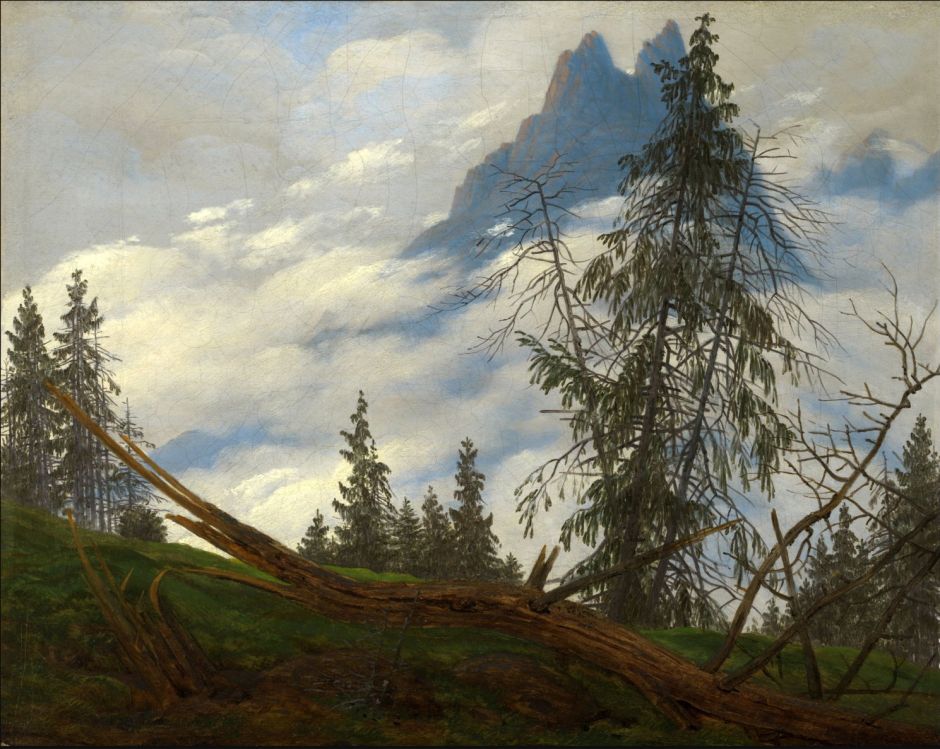
Mountain Peak with Drifting Clouds (c 1835) may be another presentation of the Watzmann, seen in full daylight and from a slightly different angle. It shows wooded and grassy slopes in the foreground, the splintered trunk of a fallen tree crossing the front of the painting. Behind is a sloping mass of cloud, largely covering more rugged ground which rises to a double peak, set in line with foreground trees.

The Stages of Life (1834-5) is set at twilight, and shows five figures and assorted fishing equipment at the water’s edge, with five boats sailing in to the shore behind them. Two of the figures are children, who raise a small Swedish flag between them. (Friedrich had been born in Swedish territory, Pomerania, but opted for German nationality and settled in Dresden.) To their right is a young woman, pointing and looking towards the children. To their left is a mature man, wearing a top hat, who is turned towards an elderly man, the closest to the viewer, his back towards us and a walking stick in his right hand. The younger man is gesticulating, his right hand towards the old man, his left pointing down towards the children.
The ships mirror the figures. Closest in to the shore are two small fishing boats under full sail. Still out in the deeper water behind them is a fully-rigged ship in the process of furling its sails. Further in the distance is a larger fully-rigged ship, also furling its sails, and on the horizon is the fifth, large ship, its sails still fully set.
This well-known painting has been interpreted as showing, in both figures and vessels, the ‘five stages of life’. However it is more enigmatic than that. Neither of the children is a baby, and their corresponding boats are of similar size too. The children and two younger adults appear to form a family group, with the obvious visual reference to Sweden, and could represent Friedrich, his wife, and two of their three children. Alternatively the children could be Friedrich’s brother (who tragically drowned in childhood) and a sister.

Seashore by Moonlight (1835–6), one of his last oil paintings, is a nocturne, very dark, and lit by a moon seen indistinctly behind cloud, at the very top of the painting. Three small fishing boats are shown at different distances from a rocky shore. Two small rowing boats are just visible in the gloom of the foreground, and there are black shadows of fishing gear. The horizon is lined by the bright reflection of the moon, the brightest tone in the whole painting, and moonlight glints on the central area of sea. The clouds are deep indigo, in smooth folds and curves threatening rain.
Friedrich’s paintings have several common and recurrent themes: death, twilight and darkness, vision obscured by cloud and fog, loneliness amid the great expanse of wilderness, ships and the sea, permutations of one or two men wearing tricorn hats, and one or two women, usually facing into the distance, barren and twisted trees.
It is perhaps unsurprising that amid this tragedy in the landscape, Friedrich suffered several bouts of depression, and his visions were perhaps his expression of what Churchill later referred to as his “black dog”.
References
Wikipedia
Artble
Hofmann W (2000) Caspar David Friedrich, Thames & Hudson. ISBN 978 0 500 09295 8.
Piotrovsky MB et al. (2008) Caspar David Friedrich & the German Romantic Landscape, Lund Humphries. ISBN 978 1 84822 017 1.
Landscape as the portal to higher vision
Samuel Palmer’s (1805-81) life, artistic career, and work have been documented meticulously by Will Vaughan, as reviewed here. A much shorter summary is given in Vaughan’s introduction to his 2005 book.
For Palmer, nature and the material world formed the portal for his higher vision; although he was clearly looking beyond the material world, his paintings remain rooted in that world, and generally create a feeling of eeriness and otherworldliness.
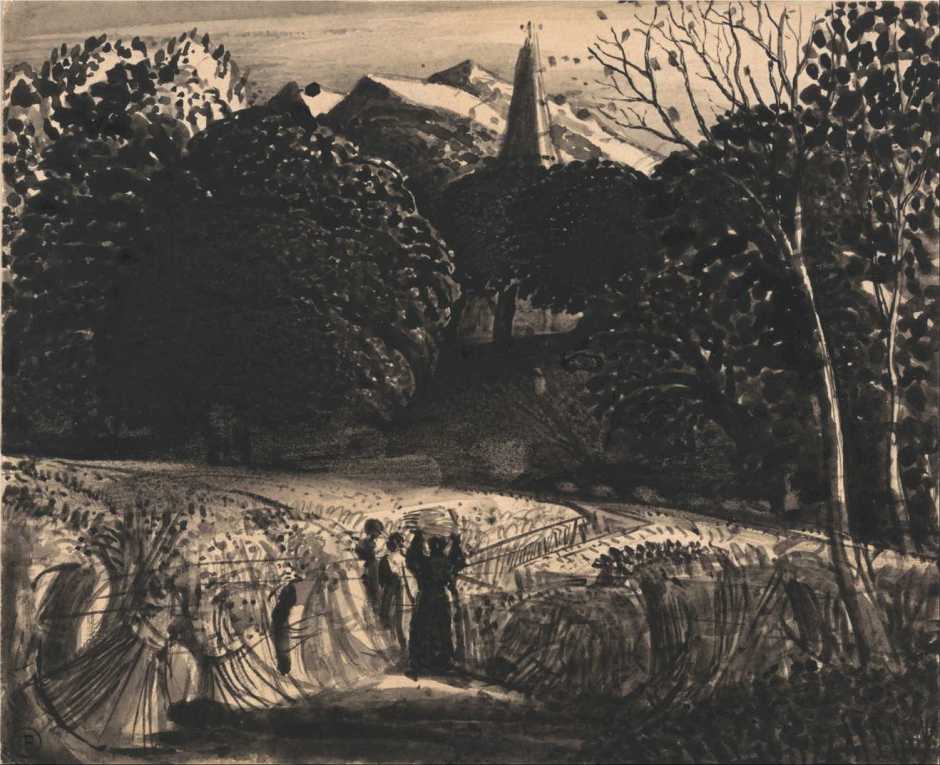
In Cornfield and Church by Moonlight (c 1830), the moon (or sun) appears low in the sky. A group of three women, who have been gleaning in the field in the foreground, are making their way back to the village in the distance. One of the women bears a basket on her head, and they are surrounded by cut stooks of corn. Beyond the field is a dark bank of trees, behind which is the spire of the village church and some roofs.
Painted during the settled phase of his time in rural Shoreham, Kent, this is at heart a pastoral idyll, which could have represented a real scene, or could be an idealised landscape. The ambiguity of lighting and the very dark shadows recall Palmer’s more overtly visionary Oxford Sepias from 1825.

The Harvest Moon (c 1833) shows many workers in a corn field under the light of a full moon, which is seen low in the sky and to the left of centre. The workers, many or all of them women, are seen cutting the corn into stooks, some of which are piled high on a cart drawn by oxen towards buildings tucked away in a bank of trees. That bank, behind the field, opens out on the right to show a winding river. The constellation Ursa Major (the Plough) is shown low in the sky above the river on the right, its stars burning brightly.
This slightly later painting from Palmer’s time at Shoreham has a heightened air of strangeness, being so clearly set at night, an unusual time to show such work. However it remains at heart another pastoral idyll, a curious image given the growing discontent in the countryside at the time. Palmer probably exhibited this at the Royal Academy in 1833, where it did not sell.
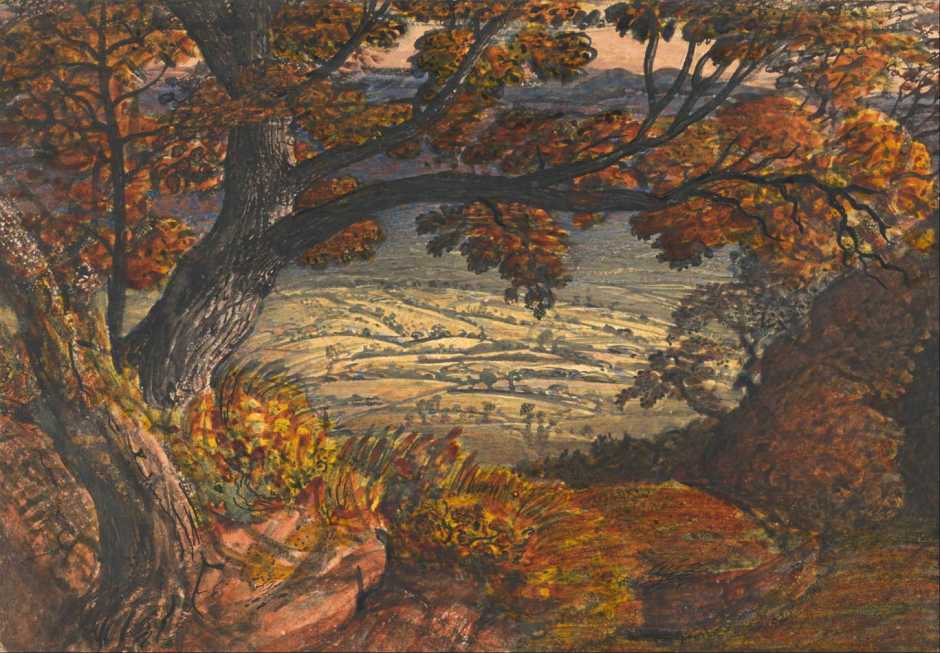
The Weald of Kent (c 1833-4) is one of several similar paintings which Palmer made of the undulating small fields of Kent, framed by a massive oak tree in full leaf, and nearby woods. Although it was first believed to represent the Darent Valley, more recently Barton and Tong have identified this view as being of Underriver, near Sevenoaks, Kent, seen from Carter’s Hill. In this version the landscape is deserted.
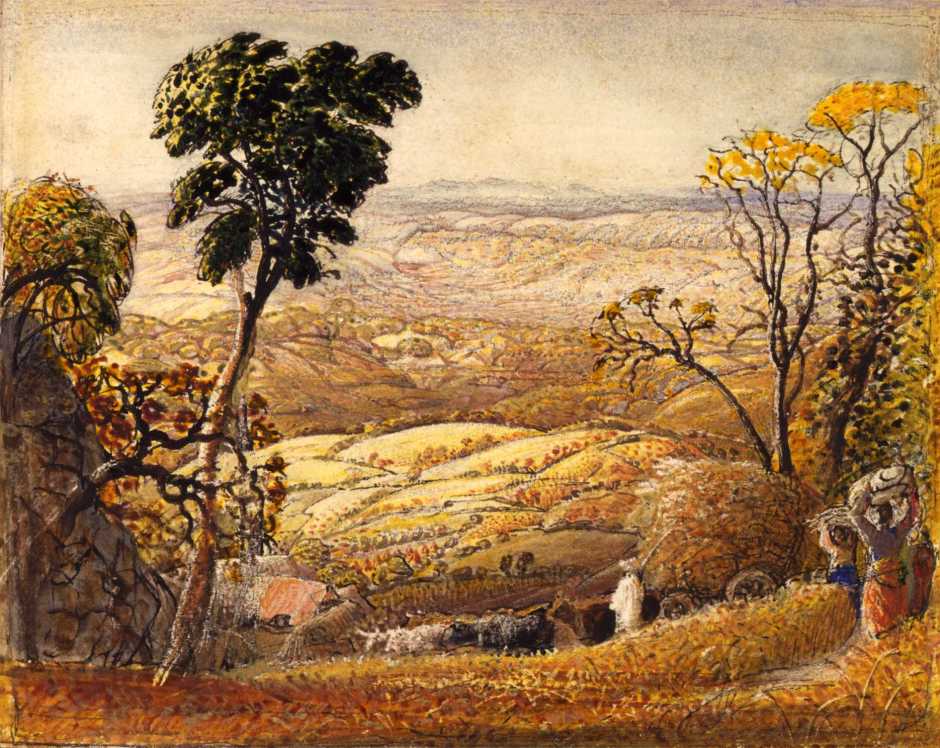
The Golden Valley (c 1833-4), also from his time at Shoreham, is a more open panorama which appears not dissimilar to The Weald of Kent, but probably shows a different view, that of Underriver, near Sevenoaks. Here framing is accomplished by smaller and more distant trees, which leave the horizon clear. Figures process in single file down the hillside, from the bottom right corner towards the low middle. At the back are three women carrying loads on their heads. In front of them is an ox cart laden with a high load of cut corn. The team of oxen appears headed towards a farm, seen below the trees on the left.
This may well represent the return of a harvesting team as shown in The Harvest Moon, and appears to be a more straightforward pastoral view.

In The Shearers (c 1833-5), completed towards the end of Palmer’s time at Shoreham, there are more puzzles. It shows a gang of six shearers, three men and three women, tightly grouped just outside the entrance to a barn. The massive beams of the barn frame the view; the right half of the painting contains an elaborate still life of agricultural implements, including a scythe (often associated with death), a pitchfork, threshing tools, and a basket. On these hangs a broad-brimmed straw hat (a cherished symbol of Palmer’s time at Shoreham), a small barrel, and a bottle. Beyond the shearing gang light trees add further framing, and there is vague, rolling countryside in the distance.
Various attempts to interpret this painting have failed, in one way or another. It has been thought that the shearers might be a quotation from other works, but no convincing evidence has been found. The still life was the subject of two studies, and appears very carefully composed and, like the rest of the painting, enigmatic as to its interpretation.

Christian Descending into the Valley of Humiliation (1848) show’s John Bunyan’s allegorical hero Christian (from Pilgrim’s Progress, 1678) making his solitary way down into a valley. On the left are buildings with a dominating tower, set amid trees. In the far distance are hills, within which is a brightly lit town. Otherwise the hills are swathed in the indigo clouds of bad weather, which ends above the horizon to the right, where the sky forms a bright line. Christian is clad in the armour and bears the shield and sword given earlier in the book, by the virtues of Discretion, Prudence, Piety and Charity.
Palmer’s friend William Blake (who had died 21 years before this was painted) had also illustrated Pilgrim’s Progress; whilst there may have been an element of tribute in this painting, its style and influence by Salvator Rosa, Claude, Turner, and Linnell are distinctive. It also shows a recurrent theme in Palmer’s later work, that of the lonely tower, and may also refer to another, that of clouds piled towards heaven.
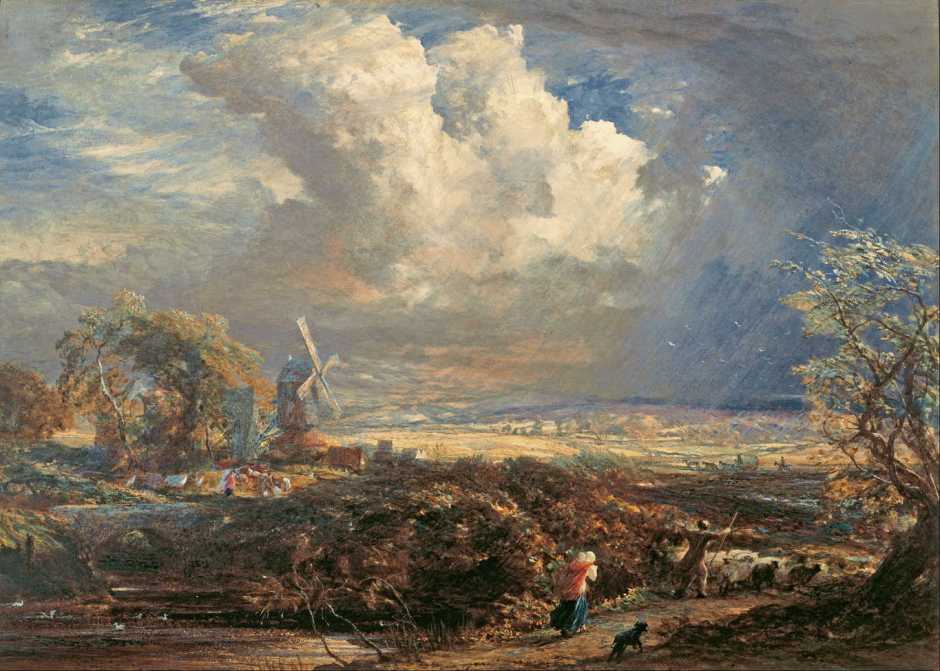
Summer Storm near Pulborough, Sussex (c 1851) is unusual for Palmer in referring to Dutch landscape paintings, but in a very Kentish context. A storm is seen approaching the rolling countryside near Pulborough, Kent. In the foreground a shepherd is trying to control his flock of sheep, a woman behind carrying a child in a sling on her back, a small dog close by. As the wind rises, trees and shrubs which are in full leaf are swept by it.
On the left, in the middle distance, a small bridge leads across to a hamlet set around a prominent windmill, whose blades are blurred as they are driven by the wind. Women are rushing to bring their washing in before it rains. Further into the distance the sun is still shining on the fields, but to the right the grey-blue darkness of clouds, scud clouds, and streaks of heavy rain are already edging across. In the middle of the sky there are two towering cumulo-nimbus clouds.
Although his later work may appear more conventional, Palmer continued to include his favourite and probably symbolic themes, here that of the towering cloud, which he had developed earlier. It is also possible that the windmill is an iteration of the lonely tower.

Sunset (1861) is one of a number of paintings made by Palmer in his later years, depicting idyllic pastoral scenes as the sun is setting. In the same year he painted a related view of the ruins of Tintern Abbey at sunset, and it is possible that this was intended as a pendant, which is composed as a mirror image.
In the left foreground a couple are resting on the ground, talking, in front of the corner of a field of ripe grain. In the centre foreground cattle are standing in a small river, possibly at a ford. On the bank to the right there is a worn path leading to a dark overshot watermill, in front of which is another figure. The mill and surrounding buildings are in shadow, and spread across towards the edge of the corn field. Three prominent trees are lit brightly by the golden yellow of the sun, which is just above the horizon, slightly to the right of centre. One of those trees is on top of a rocky hill in the right distance, which partly shields the viewer from the sun. The sky is full of rows of ‘mackerel’ clouds, tinged pink and light orange by the sun.
This was painted in the year that Palmer’s elder son died, driving him to live as a virtual recluse with his remaining family in Redhill, Surrey. He then returned to darker and densely-worked paintings developing the lonely tower theme, in his final years.
Palmer’s Romanticism was more subtle than Friedrich’s, but put beside other landscape paintings of the day, many of Palmer’s have a distinctive look with their golden glowing fields of ripe grain, unusual light, and general eeriness or foreboding. This is particularly true of his earlier work, before and during the time spent at Shoreham, but themes developed then run on through his later work too.
References
Wikipedia
Vaughan W, Barker EE, Harrison C et al. (2005) Samuel Palmer. Vision and Landscape, British Museum Press. ISBN 978 0 7141 2641 8.
Vaughan W (2015) Samuel Palmer. Shadows on the Wall,, Yale UP. ISBN 978 0 300 20985 3.
Summary
Landscapes which are overtly influenced by the artist’s vision are relatively unusual, but generally quite distinctive. Depending on the artist’s personal vision, they are likely to use:
- optical effects, particularly transient or partial lighting, such as twilight, moonlight, or the effects of heavy cloud,
- cloud, fog and other devices which obscure part of the motif,
- recurrent or repeated (sometimes even obsessional) themes and subjects, which are often unusual or strange,
- deliberate depopulation,
- crafted figures, which can amount to possible narrative,
- symbolic objects, or allegorical passages,
- enigma and difficulty in resolving an interpretation.

